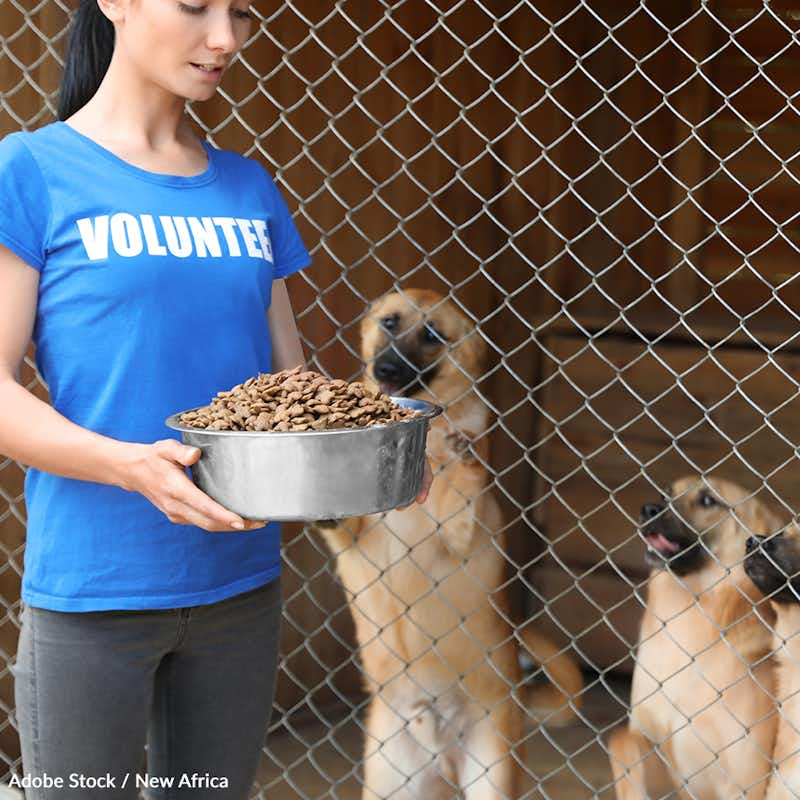Support Pet Food Pantries And Keep Families Together
12,786 signatures toward our 30,000 Goal
Sponsor: The Animal Rescue Site
No one wants their pet to go hungry. Pet food pantries provide peace of mind to many struggling people. Take the pledge and support pet food pantries!

Did you know that financial difficulty is one of the top five reasons pets are surrendered to animal shelters?
Even food stamps cannot be used to purchase pet food1.
It's in these challenging situations that pet food pantries provide crucial support. Across the United States, pet food pantries and food banks provide a lifeline to animals in need, helping keep them in their homes2.
Pet food pantries help keep pet families together by making sure they have have what they need to survive. They also keep loved pets out of entering shelters, making space for other animals who have no home3.
Many people experiencing food insecurity will make sure their pets eat before they do. This situation affects vulnerable Americans, including the elderly, the homebound, or those experiencing housing insecurity4.
The fact is, tens of millions of pets live with families in poverty who struggle to care for them5. Approximately 3.5 million Americans are homeless, with an estimated 10% having dogs or cats as companions. Pet food pantries can help many pet parents meet that responsibility6.
Some food banks are large city or statewide organizations that stock both people and pet food in warehouses6. This food is then transported to local agencies where it is distributed to those in need. Other communities have smaller pet food pantries run by animal shelters in partnership with social service or religious organizations7.
Pet food pantries often rely exclusively on public donations, but there are many other ways you can help support the work of pet food pantries across the U.S.
Take the Pet Food Pantry Pledge and help keep families together during difficult times!
- Vera Lawlor, pawtracks (24 October 2021), "Why pet food pantries are a lifeline to animals in need and how you can help."
- Winnie Hu, The New York Times (7 February 2015), "Pet Food Pantries Offer Relief to Animal Owners Struggling With Bills."
- Columbus Humane, "Pet Food Assistance Program."
- Casey Bond, Arluke, A., faunalytics (26 April 2022), "Coping With Companion Animal Food Insecurity."
- The Humane Society of the United States (2022), "Keeping Pets for Life."
- National Coalition for the Homeless"How Many People Experience Homelessness?."
- Food Bank News (13 October 2022), "Top 10 Food Banks, by Revenue."
- Community Pet Center, "FREE Pet Food Pantry."
The Pledge:
As an advocate for the health and wellbeing of all companion animals, I acknowledge the importance of Pet Food Pantries across the United States, and pledge to support them through the following actions:
7. Organize a food drive
A food drive is a great way to support a pet food pantry.
To start your own pet food drive, you will first need to organize your team with friends and family. Then you will need to find location for your drive, potentially one hosted by a popular pet food store. In the weeks leading up to the drive, spread the word via social media and by posting flyers around the community.
6. Help transport food
Many pet food pantries are staffed by volunteers who collect food donations from retailers and local businesses and deliver it to the homes of clients or social service organizations.
Volunteering a little of your time each month to transporting pet food can make a big difference in the lives of pet parents in need.
5. Help with food intake
Food intake is an important job at pet food pantries, especially during on-site food drives when help is needed getting critical supplies from donors.
4. Help with food pickup
Pantries need someone to hand out food, carry bags to clients’ cars, and keep a record of the food being distributed. There may be set days and hours for food pickup at your local pantry, but volunteer help is likely always appreciated.
3. Help keep food stocks organized
After food donations are brought into a pantry, they may need to be organized to fit in the space, or to be more convenient for pet parents who will need it in the future. Volunteers can help by organizing food on pantry shelves and preparing bags for distribution. Larger bags of food might even need to be portioned out into smaller amounts for transport and distribution.
2. Help in the office
Not all pet food pantry work concentrates on kibble. Application forms need to be recorded and clients must be contacted for important information about their pets. Office volunteers also have the opportunity to market for the pet food pantry through blogs, newsletters, or social media posts.
1. Donate money
All pet food pantries have operating expenses, and all of them rely on purchasing food when it is not donated. Many pet food pantries may have a wish list of needed supplies, which may include food items, but money is helpful in any situation.
Not everyone can make the same commitment to helping pet food pantries, but by taking this pledge we can raise awareness of the importance of keeping these resources in tact.
I hereby pledge to support the work of pet food pantries as they help keep pet families together by making sure they have have what they need to survive, keep loved pets out of entering shelters, and make space for other animals who have no home.
Pledged by,